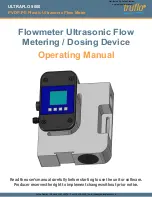
CS135 Ceilometer
4
2.1 Introduction
The CS135 is a LIDAR (LIght Detection And Ranging). It emits short pulses of
near infra-red light into the atmosphere from a semiconductor laser. These are
scattered back by aerosols including cloud droplets. The time between
transmission of the pulse and the return signal gives the range, and therefore
height, of the scattering aerosols. The variation in the strength of the backscattered
light signal with height gives a profile of scatter coefficients and allow cloud
bases to be identified. If significant scattering is detected but there is no defined
cloud base then a vertical visibility can be calculated.
Cloud heights are calculated from the scatter profile as follows: -
Close range signal distortion is removed (the signal response is effectively
flattened).
The signal amplitude is range corrected.
This is then inverted (using the Klett inversion technique) and a cloud extinction
profile is calculated.
Likely cloud bases are estimated based upon changes in slope of the extinction
profile and an extinction threshold. This threshold is based on the extinction
coefficient and is equivalent to a visibility (MOR) of 1000m. This results in a
number of possible cloud bases at different heights.
The original flattened signal is also passed through three frequency filters to
produce three different filtered back scatter profiles. Peaks in each of these
filtered profiles are detected using thresholds based upon the filter bandwidth used
and the high frequency signal noise level. This results in another set of likely
cloud bases.
Cloud bases are reported by the sensor only when the likely cloud bases
candidates by these two methods above correlate, i.e. the peaks are seen by both
processing methods.
To report a cloud layer above a lower one the scatter coefficient first has to fall
below the extinction threshold used for cloud definitions (less a small hysteresis
offset). The scatter profile must then again meet the criteria above.
To avoid many very narrow close layers being reported when they have little
significance a minimum separation based on WMO reporting intervals is applied.
After the scatter coefficient has fallen below the threshold a new cloud base will
not be reported until it has stayed below this threshold for at least a set interval.
This interval varies, increasing with height.
If no clouds are detected the CS135 will give one of the following reports:-
•
No significant backscatter.
•
Full obscuration determined but no cloud base detected. This is reported if the
criteria for detecting cloud base is not met but the integrated scattering
coefficient reaches the limit of vertical visibility below 2,000 m. The height at
which this occurs is given as vertical visibility.
•
Some obscuration detected but determined to be transparent is reported if
scattering is detected but no cloud is detected and the calculated vertical
visibility exceeds 2,000 m.
Summary of Contents for CS135
Page 1: ...CS135 Ceilometer User Guide Issued 18 3 13 Copyright 2012 2013 Campbell Scientific Ltd CSL 950...
Page 2: ......
Page 4: ......
Page 6: ......
Page 19: ...User Guide 11 Fig 4 2 Setting the Tilt Angle...
Page 62: ...CS135 Ceilometer 54 LINE 3 ETX CR LF ETX End of Text Character CR LF Carriage Return Line Feed...













































